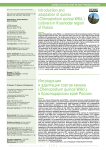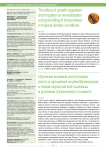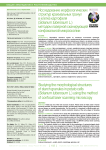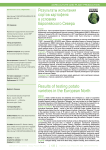Общее земледелие и растениеводство. Рубрика в журнале - Овощи России

Краткое сообщение
Quinoa (Chenopodium quinoa Willd.) is a cultivated plant of the Amaranthaceae family of Peruvian origin with high nutritional value. The Krasnodar region of Russia is a region with favorable climatic conditions for growing quinoa. The studies were carried out on the basis of Quinoa Center LLC, located in the Novokubansky district of the Krasnodar Territory. Four quinoa varieties were used as research material: Blanca de Juli, White Peru, Salcedo, the local variety Seva (included in the State Register of the Russian Federation in 2017) served as the standard. Various morphological parameters of plants were assessed and phenological observations were carried out. The results showed statistically significant differences between varieties in plant productivity. The White Peru variety responded positively to the new conditions and was introduced without irrigation. The productivity of the panicle was on average 100 g, for the standard variety Seva - 70 g. In the dynamics of the ontogenetic development cycle of four quinoa varieties, it was established that the optimal sowing time in the conditions of the Krasnodar Territory is May. The tested varieties were also assessed for grain quality. In the conditions of the Krasnodar region they showed good results, thanks to selection for white grain and panicle uniformity. However, not all of them can be adapted, since they need constant watering and for late-ripening varieties autumn rains negatively affect their yield. The local early ripening variety Seva is of interest to Peru. In Peru, the main problem reducing production is low yield caused by frost in the Puno Peru region. The Seva variety reaches phenological phases: the beginning of panicle formation (R6), panicle formation (R7), flowering (R8) and full panicle ripening, physiological maturity (R12) and due to its early ripening it avoids frost. Therefore, the Seva variety can be recommended for sowing in the Puno-Peru region, since it has a gene pool that provides cold resistance but this requires detailed study. In general, to optimize the introduction of quinoa in Russia further research on adaptability in the Krasnodar region is necessary.
Бесплатно

Статья научная
To study the remobilization rate affected by growth regulators in wheat a field experiment was carried out in the south of Iran over 2017-2019 with a split-split plot design and three iterations in completely randomized blocks. The main plots were two irrigation regimes (full irrigation and irrigation interruption at the grain-filling stage), two wheat cultivars (Chamran 2 and Durum Karkheh cv.s) were as sub plots, and four growth regulators (control (no growth regulator), salicylic acid, jasmonic acid, and cytokinin) placed in sub-sub plots. Results revealed the significant impact of the triple interaction on grain yield. The highest grain yield (4803 kg/Ha) was observed for Chamran 2 cv. treated with complete irrigation and salicylic acid. Although grain yield declined by 15.5% in the Karkheh cv. with irrigation interruption at the grain-filling stage and non-administration of growth regulators, treatment with salicylic acid managed to attenuate the adverse impact of drought stress in grain yield. The highest current photosynthesis and its contribution were observed in cultivars treated with complete irrigation. Moreover, irrigation regimen and growth regulators each had significant impacts on proline, catalase enzyme, and stomatal conductance. Overall, results suggested that using salicylic acid in Chamran 2 cv. would be advisable to increase growth and grain yield and reduce decline under stress.
Бесплатно

Статья научная
Актуальность. Картофель является одним из основных источников крахмала. Картофельный крахмал широко используется в хозяйственной деятельности человека. Его содержание в клубнях, в том числе количество крахмальных гранул и их размер и величина, в большей степени сортовой признак. В связи с этим крайне важно на начальных этапах селекции выделить сорта с показателями крахмальных зёрен, пригодных для получения крахмала. Материал и методы. Цель исследования - изучить морфологическую структуру крахмальных гранул в клетке клубней сортов картофеля различных групп спелости. Объектом исследований служили 18 сортов картофеля (Solanum tuberosum L.) различного происхождения и групп спелости. Гранулометрический состав определяли методом флуоресцентной микроскопии. Исследования проводили с помощью конфокального лазерного сканирующего микроскопа CLSM 800 (Zeiss, Германия) с длиной волны возбуждающего лазера 488 нм.
Бесплатно

Результаты испытания сортов картофеля в условиях Европейского Севера
Статья научная
Актуальность. Сорта картофеля Евразия и Онежский выведены в результате сотрудничества Мурманской сельскохозяйственной опытной станции и Ленинградского НИИСХ «Белогорка» и внесены в Госреестр РФ в 2014 году (Онежский) и в 2017 году (Евразия). Для определения перспективности выращивания на Кольском Севере сорта были испытаны в условиях Мурманской области. Материал и методика исследований. Исследования проводили на опытном поле Мурманской ГСХОС - филиала ВИР в 2018-2020 годах. Образцы картофеля Евразия и Онежский получены из Ленинградского НИИСХ «Белогорка». Делянка в опыте включала 4 рядка по 15 клубней в каждом рядке. Схема посадки - 70x35 см. Повторность - четырехкратная. Расположение делянок систематическое со смещением делянок по ярусам. Оценку скороспелости проводили по одной пробной копке на 70-е сутки после посадки. В качестве стандарта использовали сорт Елизавета. Результаты обработаны методом дисперсионного анализа по Доспехову.
Бесплатно

